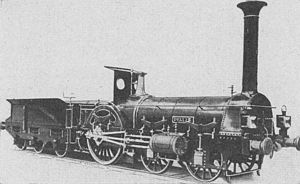Pfalz (locomotive)
| PALATINATE / THE PALATINATE | |
|---|---|
|
Photograph of the Palatinate , probably 1853
|
|
| Numbering: | 134 ( factory number of the manufacturer) 28 (company number of the Palatinate Ludwig Railway Company ) |
| Number: | 4 (3 more identical machines followed) |
| Manufacturer: | Maffei locomotive factory , Munich |
| Retirement: | 1879 |
| Axis formula : | 2A n3 |
| Gauge : | Standard gauge (1435 mm / 4 ' 8.5 " ) |
| Service mass: | 27 t |
| Friction mass: | 9.2 t |
| Indexed performance : | 200 hp |
| Driving wheel diameter: | 1850 mm |
| Impeller diameter front: | 1200 mm |
| Number of cylinders: | 2 |
| Cylinder diameter: | 356 mm |
| Piston stroke: | 610 mm |
| Boiler overpressure: | 6.25 kg / cm² |
| Grate area: | 0.98 m² |
| Evaporation heating surface: | 68.6 m² |
| Water supply: | 5 m³ |
| Drive: | 2 steam operated cylinders |
| Cruising speed 100 km / h | |
The PFALZ was a locomotive of the Palatinate Ludwig Railway Company .
designation
While the historical locomotive was named PFALZ as evidenced by contemporary image documents , its replica was named DIE PFALZ .
original
The PFALZ was the first of a series of four Crampton locomotives with a 2A wheel arrangement that the Maffei locomotive factory in Munich built for the Palatinate Ludwig Railway Company in 1853. For the first time, a locomotive was equipped with weather protection for the drivers. Because with 200 HP the locomotive could reach a cruising speed of almost 100 km / h. The PFALZ belonged to a series of express train locomotives that were given operating numbers 26 to 63 at the Palatinate Ludwig Railway .
The reason for procuring the PFALZ and its three sister locomotives from the Maffei locomotive factory was the line closure to the Hessian Ludwigsbahn and the opening of the Mainz – Ludwigshafen line at the end of the same year, which made additional machines necessary for the Mainz – Paris express train connection . The PFALZ and its sister machines drove the trains between the locomotive changing stations in Worms and Neunkirchen . The representative locomotives were also used in front of court trains.
In 1879 the PFALZ was retired.
Replica
In 1925 a replica of the locomotive was made in the Reichsbahn repair shop in Weiden , which was given the name DIE PFALZ. Some original parts were used in this replica. The occasion was the opening of the new exhibition building of the Nuremberg Transport Museum . The owner of the replica was initially the Deutsche Reichsbahn , then the Deutsche Bundesbahn . In 1985 the last use took place under its own steam at the vehicle parade on the occasion of the 150th anniversary of the railway in Germany. DIE PFALZ is exhibited in the DGEG-Eisenbahnmuseum Neustadt / Weinstraße . ( Location ). A contract between its sponsor, the German Society for Railway History , and the Museum for Transport and Technology in Berlin, which stipulated that the vehicle should be shown every five years between the two locations, has been terminated, so that the machine will now remain permanently in the Palatinate .
THE PALATINATE in the DGEG railway museum Neustadt / Weinstrasse
PALATINATE in action in front of the royal train of King Maximilian II of Bavaria
swell
- Labeling on the object in the Neustadt / Weinstrasse railway museum.
Remarks
- ↑ The source ( inscription on the object ) obviously dates from the time before the privatization of the Deutsche Bundesbahn on January 1, 1994.
- ↑ As of November 28, 2017.






